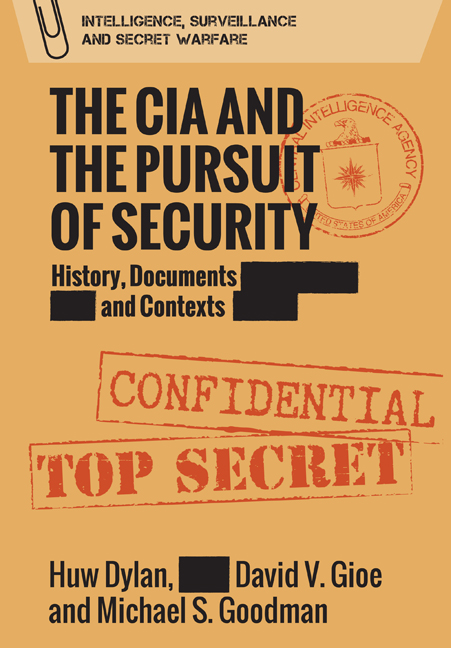Book contents
- Frontmatter
- Contents
- List of Documents
- Foreword
- Acknowledgements
- Introduction
- 1 Intelligence for an American Century: Creating the CIA
- 2 The Development of CIA Covert Action
- 3 A ‘Gangster Act’: The Berlin Tunnel
- 4 The CIA and the USSR: The Challenge of Understanding the Soviet Threat
- 5 Anglo-American Intelligence Liaison and the Outbreak of the Korean War
- 6 The CIA and the Bomber and Missile Gap
- 7 The CIA and Cuba: The Bay of Pigs and the Cuban Missile Crisis
- 8 The CIA in Vietnam
- 9 The CIA and Arms Control
- 10 The CIA’s Counter-Intelligence Conundrum: The Case of Yuri Nosenko
- 11 1975: The Year of the ‘Intelligence Wars’
- 12 Watching Khomeini
- 13 The CIA and the Soviet Invasion of Afghanistan
- 14 Martial Law in Poland
- 15 Able Archer and the NATO War Scare
- 16 The Soviet Leadership and Kremlinology in the 1980s
- 17 The CIA and the (First) Persian Gulf War
- 18 A Mole in Their Midst: The CIA and Aldrich Ames
- 19 ‘The System was Blinking Red’: The Peace Dividend and the Road to 9/11
- 20 Reckoning and Redemption: The 9/11 Commission, the Director of National Intelligence and the CIA at War
- 21 The ‘Slam Dunk’: The CIA and the Invasion of Iraq
- 22 The Terrorist Hunters Become Political Quarry: The CIA and Rendition, Detention and Interrogation
- 23 Innovation at the CIA: From Sputnik to Silicon Valley and Venona to Vault 7
- 24 Entering the Electoral Fray: The CIA and Russian Meddling in the 2016 Election
- 25 Flying Blind? The CIA and the Trump Administration
- Bibliography
- Index
6 - The CIA and the Bomber and Missile Gap
Published online by Cambridge University Press: 24 September 2020
- Frontmatter
- Contents
- List of Documents
- Foreword
- Acknowledgements
- Introduction
- 1 Intelligence for an American Century: Creating the CIA
- 2 The Development of CIA Covert Action
- 3 A ‘Gangster Act’: The Berlin Tunnel
- 4 The CIA and the USSR: The Challenge of Understanding the Soviet Threat
- 5 Anglo-American Intelligence Liaison and the Outbreak of the Korean War
- 6 The CIA and the Bomber and Missile Gap
- 7 The CIA and Cuba: The Bay of Pigs and the Cuban Missile Crisis
- 8 The CIA in Vietnam
- 9 The CIA and Arms Control
- 10 The CIA’s Counter-Intelligence Conundrum: The Case of Yuri Nosenko
- 11 1975: The Year of the ‘Intelligence Wars’
- 12 Watching Khomeini
- 13 The CIA and the Soviet Invasion of Afghanistan
- 14 Martial Law in Poland
- 15 Able Archer and the NATO War Scare
- 16 The Soviet Leadership and Kremlinology in the 1980s
- 17 The CIA and the (First) Persian Gulf War
- 18 A Mole in Their Midst: The CIA and Aldrich Ames
- 19 ‘The System was Blinking Red’: The Peace Dividend and the Road to 9/11
- 20 Reckoning and Redemption: The 9/11 Commission, the Director of National Intelligence and the CIA at War
- 21 The ‘Slam Dunk’: The CIA and the Invasion of Iraq
- 22 The Terrorist Hunters Become Political Quarry: The CIA and Rendition, Detention and Interrogation
- 23 Innovation at the CIA: From Sputnik to Silicon Valley and Venona to Vault 7
- 24 Entering the Electoral Fray: The CIA and Russian Meddling in the 2016 Election
- 25 Flying Blind? The CIA and the Trump Administration
- Bibliography
- Index
Summary
Geography ensured the relative security of the United States for most of its early history. Unlike Britain, it had no pressing need to develop a foreign intelligence capacity because it faced no real, plausible foreign threats. Technology changed this in a limited way in the 1930s. The aircraft carrier, in the possession of competitor powers in Asia, afforded them the power to threaten American naval bases. In 1941 aircraft launched from six Japanese carriers attacked the US naval base at Pearl Harbor, Hawaii, drawing the US into the Second World War. But none of the enemy powers during the war possessed the capability to inflict significant damage to the US homeland. By the end of the war, however, it was clear that geography would not afford the US the same level of security it had historically enjoyed. Scientists and engineers in belligerent countries had developed new machines that, when perfected, would allow them to attack inter-continental targets with munitions of almost unimaginable destructive power. These technologies included long-range bombers, jet-engines, ballistic missiles and the atomic bomb. The German V-2 rocket attacks on London demonstrated the vulnerability of urban centres to ballistic missiles; the attacks on Hiroshima and Nagasaki demonstrated the revolutionary power of atomic bombs. It was obvious that sooner or later these technologies – long- range delivery systems and atomic bombs – would be combined, and that when they were the US homeland would be vulnerable like never before.
The exposure of elements of Soviet atomic espionage efforts left Western leaders in no doubt about Stalin's atomic ambitions. The scale of the Soviet Union's penetration of the Anglo-American atomic infrastructure was extensive. It included reports from several members of the Cambridge Five spy ring in the UK. John Cairncross, for instance, reported to his Soviet handler in September 1941 that the British were intent upon developing an explosive device that harnessed the power of the atom. This was but the first of many reports that reached Moscow through the latter half of 1941 and early 1942; ultimately they would convince Soviet scientists that the plans were feasible, and Stalin to start work on a Soviet bomb.
- Type
- Chapter
- Information
- The CIA and the Pursuit of SecurityHistory, Documents and Contexts, pp. 100 - 111Publisher: Edinburgh University PressPrint publication year: 2020



